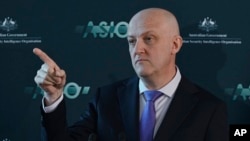Australia has five official levels under its national terrorism threat classification system, ranging from "certain" to "not expected."
The alert level has been in the middle range at "probable" since 2014, after the emergence of the Islamic State militant group in the Middle East.
It has now been lowered to "possible." This means the authorities believe that while Australia remains a potential target for terrorist attacks, there are fewer extremists intending to carry out an attack.
The de-escalation in the terror threat level was announced Monday by the director-general of ASIO, the Australian Security and Intelligence Organization, Mike Burgess.
He told reporters in Canberra that the country must remain vigilant.
"While ASIO considered all of these factors when deciding to lower the terrorism threat level I can almost guarantee it will need to go up again at some point in the future," Burgess said. "But that is no reason to refrain from lowering it now, but it is a reason for ASIO to stay on the case to continue our counter-terrorism effort to give Australian people the safety, security and assurance they deserve."
The ASIO boss also warned that there were individuals "still fantasizing about killing other Australians, still spouting their hateful ideologies in (online) chat rooms."
ASIO has publicly reported 11 terrorist attacks in Australia since 2014. Twenty-one significant extremist plots had also been "detected and disrupted."
Burgess has acknowledged Australia's security and intelligence agencies were increasingly focused on the rising threat posed by foreign interference and espionage.
He said the recent repatriation of Australian wives, widows and children of dead or imprisoned Islamic State fighters from Kurdish-run detention camps in Syria had been accounted for in the decision to lower the domestic threat level.
Home Affairs Minister Clare O'Neil told local media Monday that the Australian government and security agencies would "remain vigilant."








